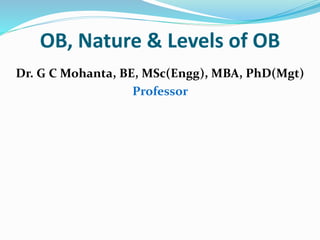
Organizational behaviour, nature & levels of organizational behaviour
- 1. OB, Nature & Levels of OB Dr. G C Mohanta, BE, MSc(Engg), MBA, PhD(Mgt) Professor
- 2. What is an Organization? An organization is a collection of people who work together to achieve individual and organizational goals Individual goals Organizational goals
- 3. Organizational Behaviour A field of study that investigates how individuals, groups and structure affect and are affected by behaviour within organizations, for the purpose of applying such knowledge toward improving an organization’s effectiveness.
- 4. Insert Figure 1.1 here Oganizational Behaviour
- 5. Why Do We Study OB? To learn about ourselves and others To understand how the many organizations we encounter work. To become familiar with team work To help us think about the people issues faced by managers and entrepreneurs
- 6. A separate field of study and not a discipline only It has assumed the status of a distinct field of study. It is a part of general management. It represents behavioral approach to management. An inter-disciplinary approach The OB is heavily influenced by several other behavioral sciences and social sciences like psychology, Sociology and anthropology. OB has psychological foundations. The concept like learning, perception, attitude, motivation etc. is borrowed from psychology, sociology and anthropology. Nature of OB
- 7. Nature of OB (contd.) A Normative Science Organizational behaviour is a normative science. A normative science prescribes how the various findings of researches can be applied to get organizational results, which are acceptable to the society. Thus, what is acceptable by the society or individuals engaged in an organization is a matter of values of the society and people concerned. A Science and Art Organization behavior is both art and science. It is considered as art because it contains knowledge about behavior of individuals. It is considered as science because it involves application of science.
- 8. Nature of OB (contd.) Humanistic and Optimistic Approach Organizational behaviour focuses the attention on people from humanistic point of view. It is based on the belief that needs and motivation of people are of high concern. Further, there is optimism about the innate potential of man to be independent, creative, predictive and capable of contributing positively to the objectives of the organization.
- 9. Nature of OB (contd.) Oriented towards Organizational Objectives Organizational behaviour is oriented towards organizational objectives. In fact, organizational behaviour tries to integrate both individual and organizational objectives so that both are achieved simultaneously. A Total System Approach An individual's behaviour can be analyzed keeping in view his psychological framework, interpersonal-orientation, group influence and social and cultural factors. Thus, individual's nature is quite complex and organizational behaviour by applying systems approach tries to find solutions for this complexity.
- 10. Levels of Analysis in OB Group Level Individual Level Organizational Level
- 11. Individual Level In individual level, organizational behavior involves the study of learning, perception, creativity, motivation, personality, turnover, task performance, cooperative behavior, deviant behavior, ethics, and cognition. At this level of analysis, organizational behavior draws heavily upon psychology, engineering, and medicine. A study of organizational behavior at the individual level of analysis might focus on the impact of different types of overhead lighting on such factors as productivity and absenteeism.
- 12. Group Level At the group level of analysis, organizational behavior involves the study of group dynamics, intra- and inter group conflict and cohesion, leadership, power, norms, interpersonal communication, networks, and roles. At this level of analysis, organizational behavior draws upon the sociological and socio-psychological sciences A study of how different personality types correspond to different leadership styles and levels of results operates at the group level of analysis.
- 13. Organizational Level At the organization level of analysis, organizational behavior involves the study of topics, such as, organizational culture, organizational structure, cultural diversity, inter-organizational cooperation and conflict, change, technology, and external environmental forces. At this level of analysis, organizational behavior draws upon anthropology and political science. The study on organizational cultures, by William Ouchi's classic Theory Z: How American Business Can Meet the Japanese Challenge (1981) is example of organizational behavior conducted at the organization level of analysis.
